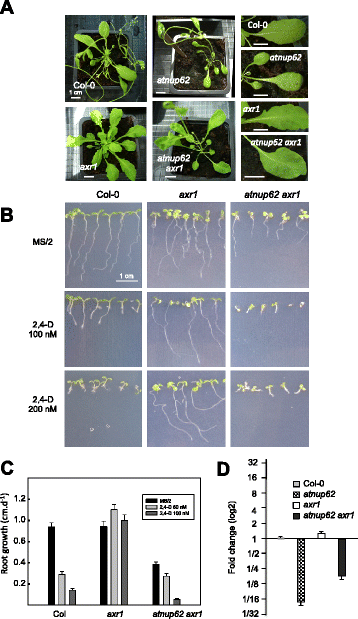Reduced expression of AtNUP62 nucleoporin gene affects auxin response in Arabidopsis
- PMID: 26728150
- PMCID: PMC4700657
- DOI: 10.1186/s12870-015-0695-y
Reduced expression of AtNUP62 nucleoporin gene affects auxin response in Arabidopsis
Abstract
Background: The plant nuclear pore complex has strongly attracted the attention of the scientific community during the past few years, in particular because of its involvement in hormonal and pathogen/symbiotic signalling. In Arabidopsis thaliana, more than 30 nucleoporins have been identified, but only a few of them have been characterized. Among these, AtNUP160, AtNUP96, AtNUP58, and AtTPR have been reported to modulate auxin signalling, since corresponding mutants are suppressors of the auxin resistance conferred by the axr1 (auxin-resistant) mutation. The present work is focused on AtNUP62, which is essential for embryo and plant development. This protein is one of the three nucleoporins (with AtNUP54 and AtNUP58) of the central channel of the nuclear pore complex.
Results: AtNUP62 promoter activity was detected in many organs, and particularly in the embryo sac, young germinating seedlings and at the adult stage in stipules of cauline leaves. The atnup62-1 mutant, harbouring a T-DNA insertion in intron 5, was identified as a knock-down mutant. It displayed developmental phenotypes that suggested defects in auxin transport or responsiveness. Atnup62 mutant plantlets were found to be hypersensitive to auxin, at the cotyledon and root levels. The phenotype of the AtNUP62-GFP overexpressing line further supported the existence of a link between AtNUP62 and auxin signalling. Furthermore, the atnup62 mutation led to an increase in the activity of the DR5 auxin-responsive promoter, and suppressed the auxin-resistant root growth and leaf serration phenotypes of the axr1 mutant.
Conclusion: AtNUP62 appears to be a major negative regulator of auxin signalling. Auxin hypersensitivity of the atnup62 mutant, reminding that of atnup58 (and not observed with other nucleoporin mutants), is in agreement with the reported interaction between AtNUP62 and AtNUP58 proteins, and suggests closely related functions. The effect of AtNUP62 on auxin signalling likely occurs in relation to scaffold proteins of the nuclear pore complex (AtNUP160, AtNUP96 and AtTPR).
Figures




References
Publication types
MeSH terms
Substances
LinkOut - more resources
Full Text Sources
Other Literature Sources
Molecular Biology Databases
Miscellaneous

